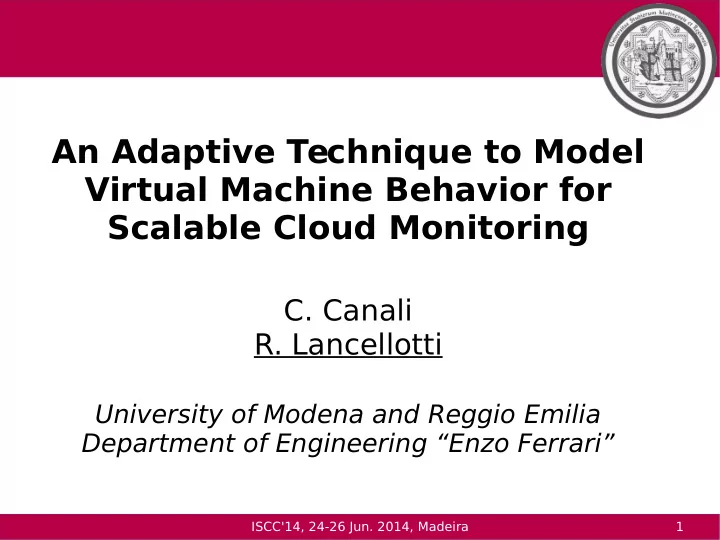

An Adaptive Technique to Model Virtual Machine Behavior for Scalable Cloud Monitoring C. Canali R. Lancellotti University of Modena and Reggio Emilia Department of Engineering “Enzo Ferrari” ISCC'14, 24-26 Jun. 2014, Madeira 1
Challenge: monitoring ● Large data centers (> 10 5 VMs) → huge amount of data ● Point of view: IaaS provider → monitoring supporting infrastructure management ● VM can be anything → treat VM as black boxes → Scalability issues ● VM VM VM VM VM VM VM VM VM VM VM VM ISCC'14, 24-26 Jun. 2014, Madeira 2
Challenge: monitoring ● Current approach: reduce amount of data in a uniform way – Reduce sampling frequency – Reduce number of metrics considered → Reduced monitoring effectiveness ● – Less information available for management ● Solution: Exploit VM similarity CL1 CL2 VM VM VM VM VM VM VM VM VM VM VM VM VM VM VM VM ISCC'14, 24-26 Jun. 2014, Madeira 3
Improving monitoring scalability ● Group similar VMs together ● Detailed monitoring of cluster representatives ● Reduced monitoring of other VMs CL1 CL2 VM VM VM VM VM VM VM VM → Data collection reduced by one order of ● magnitude ISCC'14, 24-26 Jun. 2014, Madeira 4
Challenge: fast identification ● VM behavior model built starting with time series of resource usage on VMs ● Long time series to characterize VM behavior → Highly accurate clustering – ● Clustering accuracy decreased by shorter time series → problems coping with Cloud dynamic – behavior ● Need to combine fast and accurate identification of VM behavior ISCC'14, 24-26 Jun. 2014, Madeira 5
Reference scenario ● IaaS, medium-long term commitment – Amazon Reserved instances, private cloud ● Reactive VM relocation – Local manager ● Periodic global consolidation – Global optimization ISCC'14, 24-26 Jun. 2014, Madeira 6
Our proposal: adaptive approach ● Observation: – Some VMs are easily identified as belonging to a cluster even after short observation – Other VMs require more detail to build a reliable behavior model ● Proposal: – Cluster as fast as possible VMs clearly belonging to a cluster – Postpone clustering of VMs when not sure ● Adoption of fuzzy logic perspective – Introduce decree of belonging of VM to clusters to rete reliability of clustering result – Gray area of uncertain clustering ISCC'14, 24-26 Jun. 2014, Madeira 7
Adaptive algorithm ● Adaptive identification of time series length ● When clustering is not ambiguous (white area) – VM behavior model is OK – No update required ● When clustering is ambiguous (gray area) – Need to improve VM behavior model – Further observation required ISCC'14, 24-26 Jun. 2014, Madeira 8
Definition of Gray Area ● Feature space: k-dimensional space – Each VM described by a feature vector (point in feature space) – Each cluster has a centroid described as a point in the feature space ● For each VM n: – Vector of distances from the cluster centroids n d 2, n … ,d C n } D n ={ d 1, ● Definition of gray area – A VM is in gray area iif exists a couple of n 1 −ε< d i n < 1 clusters i, j such that 1 −ε , 0 <ε< 1 d j ISCC'14, 24-26 Jun. 2014, Madeira 9
Definition of Gray Area ● Higher epsilon → wider gray area ● Problem: definition of right value of epsilon – Open problem, still working on that... – Experimental results suggest ε =0.33 as a rule of thumb ISCC'14, 24-26 Jun. 2014, Madeira 10
Case study ● Datacenter supporting a e-health Web application – Web server and DBMS – 110 VMs – 11 metrics for each VM, – Sampling frequency: 5 min ● Goal: separate Web servers and DBMS – Clustering accuracy – % of VM in gray area ● 2 VM behavior model approaches – PCA-based – Bhattacharyya distance-based December 6th, 2013 - DEIB - PoliMi 11
Experimental results Time series length: 1 day, PCA-based clustering ISCC'14, 24-26 Jun. 2014, Madeira 12
Experimental results ● Validating the choice of epsilon – For ε ≥ 0.33 the accuracy is 100% (absence of mis-classified VMs) – The size of the gray area depends on the clustering algorithms PCA-based Bhattacharyya distance-based ISCC'14, 24-26 Jun. 2014, Madeira 13
Experimental results ISCC'14, 24-26 Jun. 2014, Madeira 14
Conclusion ● Experimental results are encouraging – Can achieve high clustering purity – Can provide accurate clustering even with very short time series – Works with different clustering algorithms – Adaptive approach to select the time series length ● This is not a crystal ball – But may be a useful tool to improve monitoring and management of cloud data centers ISCC'14, 24-26 Jun. 2014, Madeira 15
On-going works ● Adaptive selection of the ε parameter ● Evaluation with time-series < 24 h ● Comparison with other fuzzy clustering algorithms ● Additional experiments with different workloads (help appreciated) ISCC'14, 24-26 Jun. 2014, Madeira 16
An Adaptive Technique to Model Virtual Machine Behavior for Scalable Cloud Monitoring C. Canali R. Lancellotti University of Modena and Reggio Emilia Department of Engineering “Enzo Ferrari” ISCC'14, 24-26 Jun. 2014, Madeira 17
Recommend
More recommend